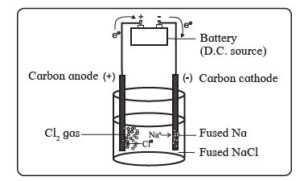chapter 5 electrochemistry class 12 chemistry textbook solution
4. Answer the following :
ii. Explain electrolysis of molten NaCl.
Answer:-

Construction of cell : The electrolytic cell consists of a container in which fused NaCl is placed. Two graphite electrodes are immersed in it. They are connected by metallic wires to a source of direct current that is battery.
The carbon electrode connected to terminal electrode of the battery is anode and that connected to negative terminal of the battery is cathode.
Reactions occuring in the cell : Fused NaCl contains Na⊕ and Cl ions which are freely mobile. When potential is applied, cathode attracts Na⊕ ions and anode attracts Cl ions. As these are charged particles, their migration results in an electric current. When these ions reach the respective electrodes, they are discharged according to the following reactions.
Oxidation half reaction at anode :
Cl ions migrate to anode. Each Cl ion, that reaches anode, gives one electron
to anode. It oxidises to neutral Cl atom in the primary process. Two Cl atoms then combine to form chlorine gas in the secondary process.
The battery sucks electrons so produced at the anode and pushes them to cathode through a wire in an external circuit. The battery thus serves as an electron pump. The electrons from the battery enter into solution through cathode and leave the solution through anode.
Reduction half reaction at cathode : The electrons supplied by the battery are used
in cathodic reduction. Each Na⊕ ion, that reaches cathode accepts an electron from the cathode and reduces to metallic sodium.
Net cell reaction
The net cell reaction is the sum of two electrode reactions.
Results of electrolysis of molten NaCl i. A pale green Cl2 gas is released at anode. ii. A molten silvery-white sodium is formed at cathode.
Decomposition of NaCl into metallic sodium and Cl2(g) is nonspontaneous. The electrical energy supplied by the battery forces the reaction to occur.
chapter 5 elctrochemistry textbook solution page 118
